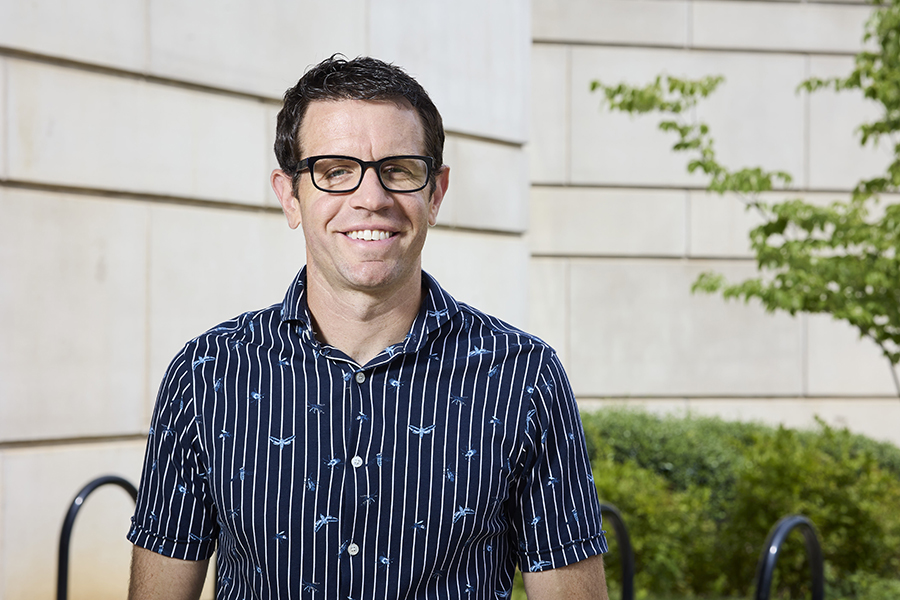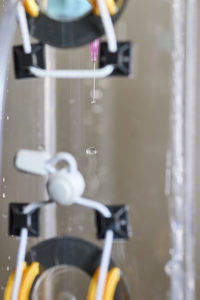 By Meghan McDonald. Photography by Shawn Poynter.
By Meghan McDonald. Photography by Shawn Poynter.
As a graduate student, Andrew Dickerson asked a question that melded his interests in fluid mechanics and nature: Can insects fly in the rain? The resulting experiment introduced him to drops—and launched his research career. “I can’t shake my fascination with drops,” said Dickerson, now an assistant professor. “At this point, I think about the world in terms of the interactions drops have with it.” This perspective led him in a new direction in 2022: toward atmospheric science.
“I became curious about how rainfall cleans the air, having witnessed how much better my allergies are after a spring rain,” he said. This phenomenon, known as precipitate scavenging, is well documented, but the physical mechanisms by which raindrops collect tiny particles in the air are not well understood. Dickerson saw a research opportunity and sensed that it would expand beyond fluid mechanics. He connected with researchers in atmospheric and climate science to understand how research on precipitation scavenging could be useful, and his interactions with those scientific communities led him to aerosols.
“Scavenging by raindrops plays a critical role in removing natural and anthropogenic aerosols, including those that contribute to climate change, from the atmosphere,” he explained. These tiny particles suspended in the air include desert dust, ocean salt spray, and carbon soot emitted by wildfires, cars, and industry. They influence how much sunlight hits the earth and how much heat the earth can radiate back toward space. Experimental limitations have prevented researchers from measuring precipitation scavenging of aerosols, so this factor has not been accurately incorporated into the complex global models that climate scientists use to predict weather patterns.

A drop of water levitating in the wind tunnel Dickerson constructed.
Dickerson proposed studying the topic by building a vertical wind tunnel that could simultaneously levitate drops and deliver a range of aerosol particles. NSF awarded him a grant through its EAGER (Early-Concept Grants for Exploratory Research) program, which funds high-risk, high-reward projects based on novel approaches and perspectives.
To prepare for constructing the wind tunnel, Dickerson visited the Mainz Wind Tunnel facility in Germany. There he watched the state-of-the-art facility in action. It can control wind velocity almost instantaneously thanks to enormous pumps that, Dickerson notes, are nearly the size of his office.
Based on that experience, Dickerson adjusted his initial wind tunnel concept to match the size of his space and funding. In his revised approach, he could still levitate drops and introduce aerosols—just not at the same time.
Once he solved that challenge, he designed the tunnel so that the wind speed can match the terminal velocity of the largest water droplets he will use, about 9 meters per second.
“The design turned out to be this beautiful organic shape to funnel air where the drops are,” Dickerson said. “I couldn’t just take the drawing to a machine shop, so my undergraduate assistant and I built it in CAD and had it 3D printed.”
The five-foot-tall wind tunnel sits in a heavy frame in Dickerson’s lab, positioned so the drops hang at eye level. Since its construction, Dickerson has been studying the shape of pendant drops at different wind speeds. This fall, with the help of a graduate student, he has begun piping in aerosols. They deliver the aerosols to hanging drops, deposit the water on a substrate, and study the aerosols remaining once the water dries. Each step is filmed with high-speed cameras.
“I’m a newcomer to atmospheric science, but I’m excited to use my background to open up new useful questions inside that scientific community,” Dickerson said. “In doing so, it will open new collaborations.” And those interactions will create more opportunities to see the world through the novel lens of drops.